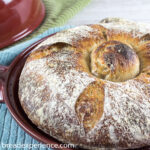Description
Pan Gallego, or Galician Bread, is a naturally leavened, high hydration Spanish Bread made with a hint of rye and whole wheat flours. The distinctive characteristic of this bread is the unique knot tied on top of the loaf prior to baking.
Ingredients
Units
Scale
Levain Build
- 10–15 grams mature sourdough starter
- 20 grams bread flour
- 10 grams whole grain rye flour
- 15 grams whole wheat flour
- 45 grams warm water
Final Dough
- 425 grams bread flour (or mix of bread flour & all-purpose flour)
- 75 grams rye flour
- 400–425 grams water, room temperature (more if needed)
- 100 grams levain
- 10 grams sea salt
Instructions
Build the Levain
- In a small bowl, mix the starter (it can be cold from the fridge), flours, and warm water until thorough incorporated. Cover with a kitchen towel or bees wrap, and let rest at warm room temperature for 3 to 4 hours, or until doubled in size. Use the levain immediately, or refrigerate it for 12 hours to use later. (Placing it in the refrigerator overnight worked better with my schedule.)
Day 1 – Mix the Final Dough
- The key to hand mixing high hydration dough is to add the water as slowly as possible.
- Place the flours in a large bowl. Pour in 325 grams of water and mix thoroughly.
- Add 25-50 grams more water, a little at a time, until you have a wet, sticky dough. Let rest 45 min.
- Add the levain and 25 grams water. Mix to dissolve the levain. Let rest for 1 hour.
- Add the salt and 15-25 grams water. Using your fingers, squeeze the salt and water into the dough until you have a smooth surface.
- Complete a total of 2 stretch and folds every 30 minutes. I performed the coil method in the bowl instead of stretching and folding the dough. To perform coil method, complete large folds in thirds, then rotate 90 degrees, and fold in thirds, let rest 30 min. Repeat.
- Let the dough bulk ferment for 4 hours. The dough should be smooth and have a bubbly surface.
- Transfer the dough to a floured surface and shape into a boule. Place in a lined and floured banneton basket. Cover, and allow dough to proof for 2-3 hours at warm room temperature.
- Cover tightly and place basket in the refrigerator to cold ferment 8-10 hours (or longer if it works better with your schedule)
Day 2 – Form the Knot and Bake
- Remove the dough from the refrigerator 1-2 hours before you plan to bake to allow it to warm up to room temperature.
- Preheat the oven to 500 degrees with a baking steel/stone, Dutch Oven, bread cloche, or cast-iron pot on the next to lowest rack. If using a baking stone or steel, place a steam pan on the lowest rack.
- Carefully release the proofed dough from the basket onto a floured surface, seam-side down. Grab the very top of the dough with your fingers. Stretch and pull the dough up as high as you can, twist it and tie into a knot. Allow the knot to gently settle back down.
- Using a couple of bench scrapers, a large spatula, or your hands, carefully transfer the loaf to a piece of parchment. Score the dough with a bread lame or serrated knife. Scoring the loaf is optional; however, making several slashes around the outside will ensure it opens up in those areas rather than tearing during baking.
- Transfer the loaf (on the parchment) to the preheated baking cloche (or stone) and bake for 10 minutes. If using a baking steel or stone, add a cup of ice cubes to the steam pan immediately after placing the loaf onto the steel.
- Reduce the temperature to 475 degrees, remove the lid of the baking vessel pot, and bake the loaf for 15 minutes (or longer) until you have a dark, blistery crust.
- When using a bread cloche, bake the loaf 15 minutes with the lid on and 10-15 minutes with the lid off. After 10 minutes, check the loaf for browning, and if needed, move it up a shelf and continue baking for additional 5-7 minutes to allow the crust to darken.
- Remove the loaf to a wire rack to cool completely before slicing.
Notes
Adapted from New World Sourdough by Bryan Ford
- Category: Sourdough Bread
- Cuisine: Spanish
